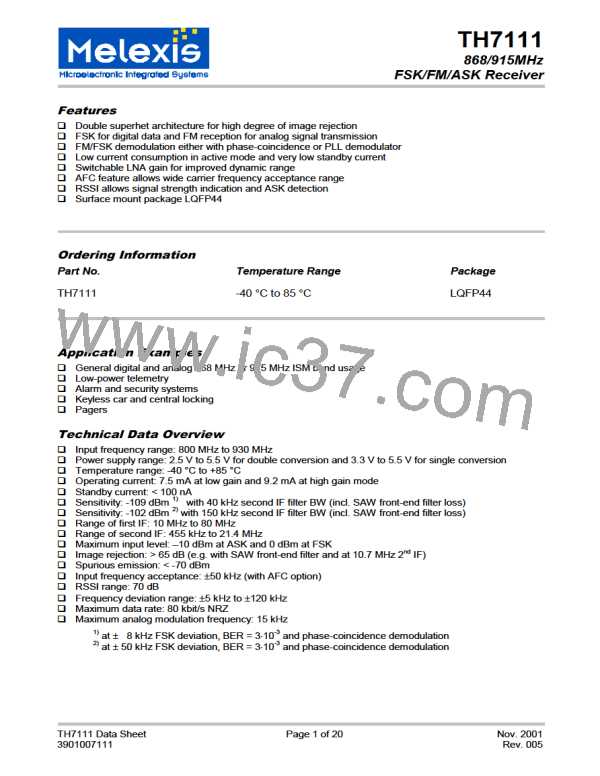TH7111
868/915MHz
FSK/FM/ASK Receiver
General Description
The TH7111 receiver IC consists of the following building blocks:
"
"
PLL synthesizer (PLL SYNTH) for generation of the first and second local oscillator signals LO1 and LO2
Parts of the PLL SYNTH are the high-frequency VCO1, the feedback dividers DIV_16 and DIV_2,
a phase-frequency detector (PFD) with charge pump (CP) and a crystal-based reference oscillator (RO)
Low-noise amplifier (LNA) for high-sensitivity RF signal reception
First mixer (MIX1) for down-conversion of the RF signal to the first IF (IF1)
second mixer (MIX2) for down-conversion of the IF1 to the second IF (IF2)
"
"
"
"
"
"
"
IF amplifier (IFA) to amplify and limit the IF2 signal and for RSSI generation
Phase coincidence demodulator (DEMOD) with third mixer (MIX3) to demodulate the IF signal
Operational amplifier (OA) for data slicing, filtering, ASK detection and automatic-frequency control (AFC)
Bias circuitry for bandgap biasing and circuit shutdown
With the TH7111 receiver chip, various circuit configurations can be arranged in order to meet a number of
different customer requirements. For FM/FSK reception the IF tank used in the phase coincidence demodu-
lator can be constituted either by a ceramic resonator or an LC tank (optionally with varactor to create an AFC
circuit). In PLL demodulator configuration, the multiplier MIX3 forms a phase comparator. In ASK configurati-
on, the RSSI signal is feed to an ASK detector, which is constituted by the operational amplifier. The second
VCO (VCO2) can be used either as the VCO of a PLL demodulator or as the LO2 source of a second exter-
nal PLL in a multi-channel system. The following table briefly summarizes the various configurations.
Single-conversion configuration
Double-conversion configuration
FM/FSK
narrow-band RX with ceramic demodulation
tank
narrow-band RX with ceramic demodulation
tank
wide-band RX with LC demod. tank and AFC wide-band RX with LC demod. tank and AFC
extended sensitivity RX with PLL demodulator extended sensitivity RX with PLL demodulator
FM/FSK
FM/FSK
FM/FSK
multi-channel RX with ceramic demodulation
tank and external channel synthesizer
RX with RSSI-based demodulation
RX with RSSI-based demodulation
ASK
ASK
RX with RSSI-based demodulation and exter-
nal channel synthesizer
The preferred superheterodyne configuration is double conversion where MIX1 and MIX2 are driven by the
internal local oscillator signals LO1 and LO2, respectively. This allows a high degree of image rejection,
achieved in conjunction with an RF front-end filter. Efficient RF front-end filtering is realized by using a SAW,
ceramic or helix filter in front of the LNA and by adding a LC filter at the LNA output.
It is also possible to use the TH7111 in single-conversion configuration. This can be achieved by switching
the LO2 input of MIX2 from the on-chip PLL synthesizer to the pin IN_MIX2 by means of an internal switch
(done via pin SW_MIX2). Now MIX2 operates as an amplifier for the IF1 signal if an external pull-down re-
sistor at pin IN_MIX2 is added.
The same setting of MIX2 can be used for multi-channel applications. In this situation IN_MIX2 must be
driven by an external LO2 signal. This signal can be generated by the VCO2, which is mainly a bipolar tran-
sistor that can be configured as a varactor-tuned VCO. Furthermore, a second external PLL for channel
selection via LO2 tuning is required. This may be arranged by using a PLL synthesizer chip that can be con-
trolled through a 3-wire bus serial interface. The reference signal for the external PLL synthesizer can be
directly taken from the crystal-based reference oscillator RO.
TH7111 Data Sheet
3901007111
Page 2 of 20
Nov. 2001
Rev. 005

 ETC [ ETC ]
ETC [ ETC ]